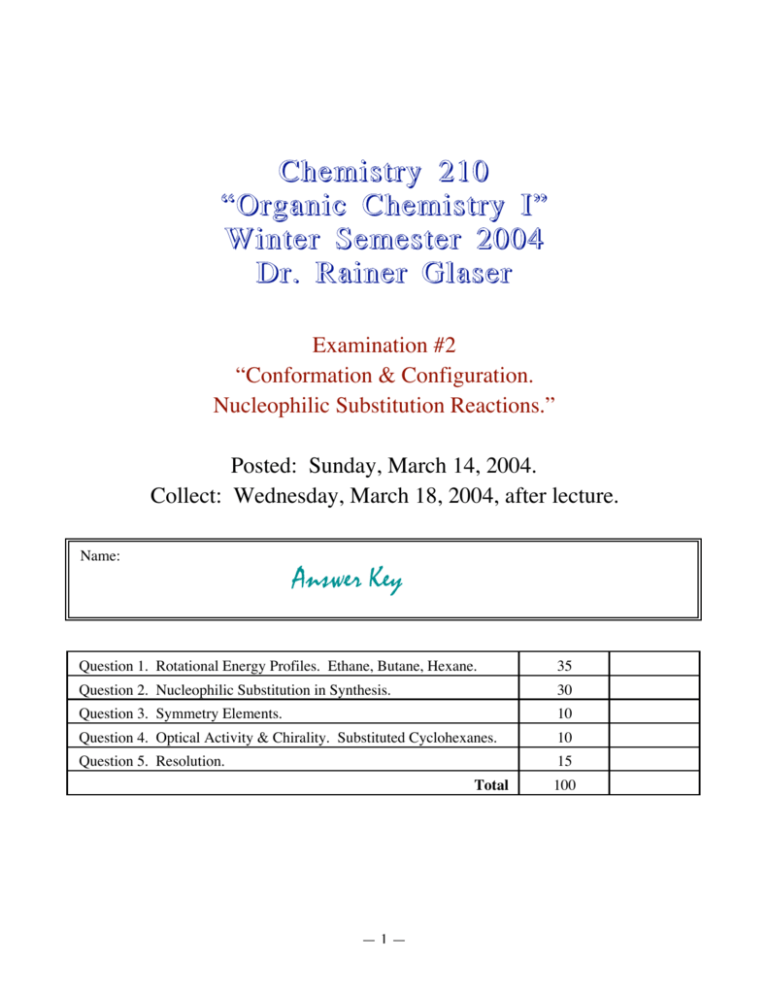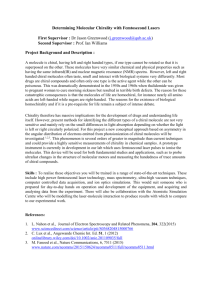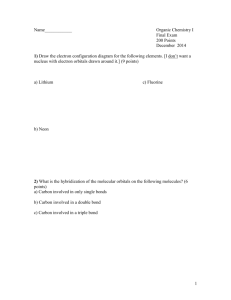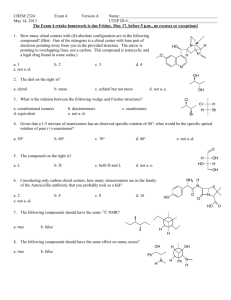Document
advertisement

Chemistry 210
“Organic Chemistry I”
Winter Semester 2004
Dr. Rainer Glaser
Examination #2
“Conformation & Configuration.
Nucleophilic Substitution Reactions.”
Posted: Sunday, March 14, 2004.
Collect: Wednesday, March 18, 2004, after lecture.
Name:
Answer Key
Question 1. Rotational Energy Profiles. Ethane, Butane, Hexane.
35
Question 2. Nucleophilic Substitution in Synthesis.
30
Question 3. Symmetry Elements.
10
Question 4. Optical Activity & Chirality. Substituted Cyclohexanes.
10
Question 5. Resolution.
15
Total
—1—
100
Question 1. Rotational Energy Profiles. Ethane, Butane, Hexane. (35 points)
(a) Draw the Newman Projections for ethane with dihedral angles 0°, 30°, and 60°. Indicate which one
is eclipsed and which one is staggered. For each structure, indicate whether it is chiral or not chiral. If it
is not chiral, give one reason as to why it is not chiral (e.g. show the presence of one symmetry element
that makes the structure achiral). (15 points)
dihedral angle = 0°
dihedral angle = 30°
dihedral angle = 60°
H
H
H
H
H
H
H
H
H H
H
H
H
H
H
H
H
H
Eclipsed or staggered?
Chiral or achiral?
Eclipsed or staggered?
Chiral or achiral?
Eclipsed or staggered?
Chiral or achiral?
3 planes (HCCH)
1 plane through C-C center
3 C2 -axes
1 C3 -axis
No planes
3 C2 -axes
1 C3 -axis
3 planes (HCCH)
3 C2 -axes
1 C3 -axis
(b) Explain in simple terms why butane is not chiral even though it can assume many, many chiral
conformations in the neighborhoods of its staggered and symmetric structures. (4 points)
In contrast to ethane, butane does not have the C3 -axis!
Now there are chiral structures.
But each chiral structure comes with its equally likely enantiomer.
Overall: No chirality.
(c) Draw the rotational energy diagram for ethane on the following page in BLUE color. (4 points).
—2—
Figure. Rotational energy profiles of ethane, butane and hexane.
Relative Energy
kcal/mol
8
Me
Me
Me
H
cis
H
H
HMe
7
6
H H
Me
H
H
Me
H
H
gauche
Me
H
5
H
4
H
H
Me
H
H
anti
3
2
1
0
0
60
120
180
240
300
360
X-C-C-X dihedral angle
X= H for ethane
X=Me for butane
X=Et for hexane
(d) Draw the rotational energy diagram for butane about the C2-C3 bond in the above graph in RED
color. Draw Newman projections of the minima and maxima and provide their names. (8 points).
(e) QUALITATIVELY, draw the rotational energy diagram for hexane about the C3-C4 bond in the
above graph in GREEN color. (4 points)
—3—
Question 2. Nucleophilic Substitution in Synthesis. (30 points)
Show complete Lewis-Kekule structures, do not use abbreviations. 6 points each question.
Cyclohexyl iodide reacts with sodium azide by way of an SN2 reaction. Draw structures for
substrate, reagent, and product.
Na
H
I
N
N3
N
N
N
H
N
N
H
Suggest a synthesis of 4-(cyanomethyl)cyclohexene by way of a nucleophilic substitution of a
tosylate by cyanide. Draw structures for substrate, reagent, and product. Suggest a solvent for the
reaction.
+ NaCN
1
4
2
OTs
ethanol/water
or DMSO
1
N
4
2
C
3
3
Suggest a synthesis of propyldecanoate by way of a nucleophilic substitution with a carboxylate as
the nucleophile. Draw structures for substrate, reagent, and product. Suggest a solvent for the
reaction.
Br
O
O
acetone
H19C9
O
Na
water
- NaBr
—4—
H19C9
O
Draw perspective drawings of the structures of the substrate and of the products of the hydrolysis of
(R)-(-)-2-bromooctane assuming that the reaction is completely SN1 and provide complete names of
the products.
OH
Br
CH3
H13C6
OH
CH3
H13C6
+
H13C6
H
H
CH3
S
R
R
H
2-octanol
Consider ethyl isopropyl ether and ethyl propyl ether. Only one of these ethers can be made by the
reaction of sodium ethoxide with an alkyl bromide. Which one? Draw structures for substrate,
reagent, and product of this case. Why does it work in this case but not the other?
Br
O
O
Na
Clean SN2 at primary alkyl bromide.
The secondary bromide would lead to some elimination as well.
—5—
Question 3. Symmetry Elements. (10 points)
For each of the M. C. Escher paintings, write to its right what symmetry elements are present (inversion
center, symmetry plane(s), rotational axes), indicate all of the symmetry elements in the paintings, and
make a conclusion as to whether the painting is symmetric, asymmetric, or dissymmetric and as to
whether the painting is chiral.
No inversion center.
No plane.
No rotational axis (note the pens).
ASYMMETRIC!
CHIRAL!
M. C. Escher, Drawing Hands
C3 axis (trough center, perpendicular to
paper plane).
3 symmetry planes (perpendicular to
paper plane, 6-to-12, 4-to10, 8-to-2)
SYMMETRIC.
NOT CHIRAL.
M.C. Escher, Angels & Devils
—6—
Question 4. Optical Activity & Chirality. Substituted Cyclohexane. (10 points)
The specific rotation [α] is given by [α] = 100 α / (c l), where α is the measured optical rotation, c is the
concentration in grams per 100 mL and l is the length of the polarimeter tube in decimeter.
(a) The observed rotation α of a 0.3 g sample of cholesterol in 15 mL chloroform contained in a 10 cm
polarimeter tube is –0.78°. Determine the specific rotation of cholesterol. Show work. (3 points)
[α] = 100 • (-0.78°) / ( [100 • {0.3 g/ 15 mL}] • 1 dm)
gram in 100 mL
1 dm = 10 cm
[α] = 39°
(b) The optical rotation is usually specified by the [α]D value. What is the significance of the subscript
“D”? (3 points)
The D-line of the sodium lamp is used, yellow at 589 nm.
The optical rotation varies with the wave length of the light that is being rotated. (Dispersion.)
(c) Draw a perspective drawing of the best conformation (most stable) of (R,R)-trans-1,2dichlorocyclohexane. This molecule is _________ (symmetric, asymmetric, dissymmetric). (4 points)
Cl
H
H
H
Cl
Cl
Cl
H
minor
major
—7—
Question 5. Resolution of racemic 1-phenylethylamine with pure (S)-(-)-malic acid. (15 points)
Answer the following questions at the appropriate place in the flow diagram.
(a) Draw perspective drawings of the S- and R-enantiomer of 1-phenylethylamine.
(b) Draw a perspective drawing of (S)-(-)-malic acid.
(c) Draw perspective drawings of the diastereoisomeric salts formed.
(d) Indicate how the diastereoisomeric salts are separated.
(e) Specify the reagent needed to liberate the free base after separation.
(S)-1-phenylethylamine
(R)-1-phenylethylamine
NH2
NH2
R
S
H5C6
H
CH3
H5C6
CH3
H
+
(S)-(-)-malic acid
OH
S
HOOC
COOH
C
H2
H
Forms
Salt 1
Salt 2
NH3+
H
H5C6
HOOC
CH3
COO-
C
H2
S
OH
NH3+
OH
CH3
H5C6
HOOC
H
H
H
S
R
S
COO-
C
H2
Separate by __Crystallization_________
Salt 1
Salt 2
Liberate free base using ___NaOH_____
Liberate free base using __ NaOH ____
(S)-1-phenylethylamine
(R)-1-phenylethylamine
—8—



